#887 Surveyor Hops November 22, 1997
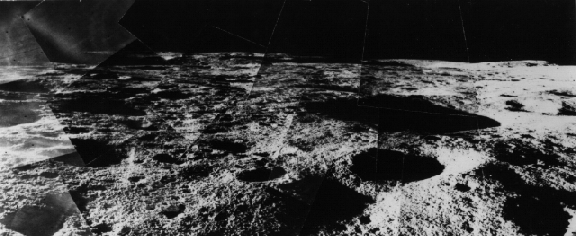
“This panorama of the cratered lunar surface was constructed from images returned by the US Surveyor 6 lander. Surveyor 6 was not the first spacecraft to accomplish a soft landing on the Moon ... but it was the first to land and then lift off again! After touching down near the center of the Moon's nearside in November of 1967, NASA controllers commanded the spacecraft to hop. Briefly firing its rocket engine and lifting itself some 4 meters above the surface, the Surveyor moved about 2.5 meters to one side before setting down again. The hopping success of Surveyor 6 essentially marked the completion of the Surveyor series main mission - to determine if the lunar terrain was safe for the planned Apollo landings."
Copyright: Public domain
#888 Triton: Neptune's Largest Moon November 23, 1997
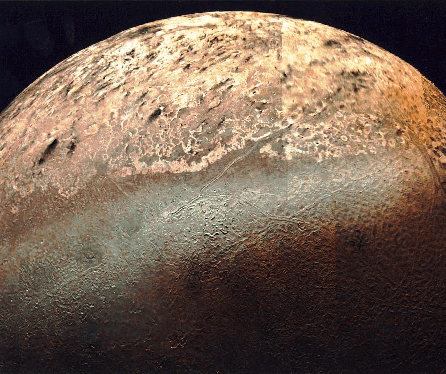
“On October 10th, 1846, William Lassell was observing the newly discovered planet Neptune. He was attempting to confirm his observation, made just the previous week, that Neptune had a ring. But this time he discovered that Neptune had a satellite as well. Lassell soon proved that the ring was a product of his new telescope's distortion, but the satellite Triton remained. The above picture of Triton was taken in 1989 by the only spacecraft ever to pass Triton: Voyager 2. Voyager 2 found fascinating terrain, a thin atmosphere, and even evidence for ice volcanoes on this world of peculiar orbit and spin. Ironically, Voyager 2 also confirmed the existence of complete thin rings around Neptune - but these would have been quite invisible to Lassell!"
Copyright: Public domain
#889 Jet Near Light Speed November 24, 1997
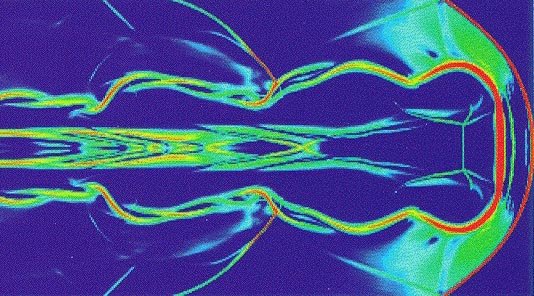
“stein's Special Theory of Relativity says that nothing can travel faster than the speed of light. Jets of protons and electrons that shoot away from objects such as quasars and black holes appear to travel at speeds approaching this maximum speed, though. Such jets carry tremendous energy and can ram straight through interstellar material. In the above frame from a computer simulation, a jet traveling only 98 percent of light speed rams and mixes with interstellar material. Even higher energy jets might well explain the structure seen around Cygnus A."
Copyright: Public domain
#890 The Comet and the Galaxy November 25, 1997
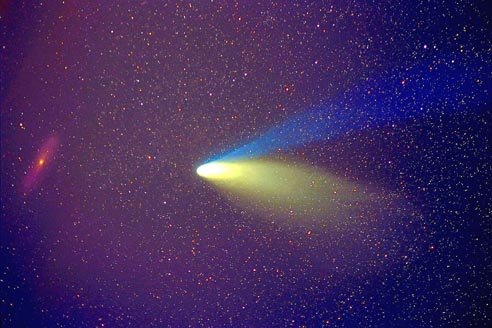
“The Moon almost ruined this photograph. During late March and early April, Comet Hale-Bopp passed nearly in front of the Andromeda Galaxy. Here the Great Comet of 1997 and the Great Galaxy in Andromeda were photographed together on March 24th. The problem was the brightness of the Moon. The Moon was full that night and so bright that long exposures meant to capture the tails of Hale-Bopp and the disk of M31 would capture instead only moonlight reflected off the Earth's atmosphere. By the time the Moon would set, this opportunity would be gone. That's why this picture was taken during the lunar eclipse."
Copyright: J. C. Casado
#891 Uranian Moons, Rings, And Clouds November 26, 1997
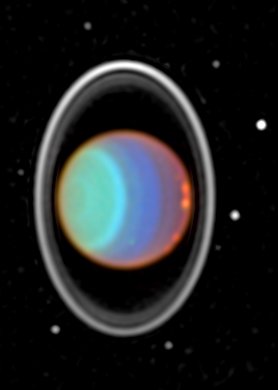
“The giant planet Uranus is faint and featureless when viewed in visible light. But this pair of near-infrared mosaics from the Hubble Space Telescope's NICMOS camera reveals moons, rings, and clouds of this distant gas planet. The color coded images highlight different atmospheric layers - blue represents the deepest layers while the highest cloud features have a reddish tinge. Racing around the planet, high, bright clouds are seen to move substantially between the two pictures taken only ninety minutes apart. Ring systems are a common to the solar system's giant planets. Here the main Uranian ring seems to vary in width and is clearly brightest near the top. The eight specks beyond the ring system are small Uranian moons which also show counter-clockwise motion over ninety minutes as traced by the arrows on the right hand image."
Copyright: Public domain
#892 Jupiter's Inner Moons November 27, 1997

“The potato-shaped inner moons of Jupiter are lined-up in this mosaic "family portrait" of these tiny Jovian satellites. The individual images were recorded over the last year by NASA's Galileo spacecraft and are scaled to the moons' relative sizes. Left to right in increasing order of distance from Jupiter are Metis (longest dimension 37 miles), Adrastea (12 miles), Amalthea (154 miles), and Thebe (72 miles). All these moons orbit in the zone between Io and Jupiter's rings, are bombarded by high-energy ions within the Jovian magnetosphere, and are probably locked in synchronous rotation by Jupiter's strong gravity. Why are they shaped like potatoes? Like the asteroids and the diminutive moons of Mars, their own gravity is not strong enough to mold them into spheres."
Copyright: Public domain
#893 Beta Pictoris Revisited November 28, 1997
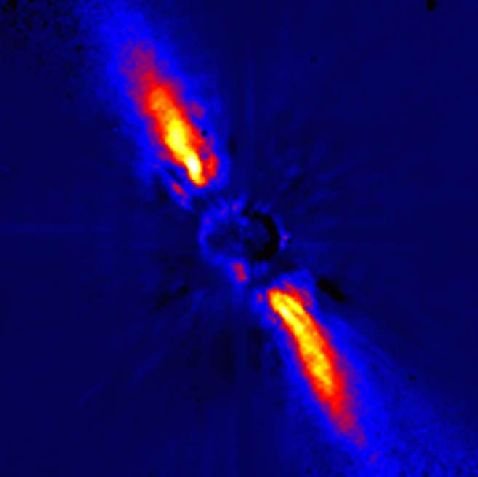
“In the early 1980s, Beta Pictoris became one of the most important stars in the sky. Satellite and ground-based telescopic observations revealed the presence of a surrounding outer disk of material and an inner "clear" zone about the size of our solar system - strong evidence for the formation of planets. Beta Pictoris is 50 light years away and any orbiting planets are too small and faint to image at that distance. But evidence continues to mount that this star indeed has comet-like bodies in the disk and a Jupiter-sized planet orbiting within the central zone. Shown here in false color, this recent, highly detailed picture was obtained at the European Southern Observatory by blocking the overwhelming direct starlight and imaging the near-infrared light from the disk. The disk's warped bright inner region is indirect evidence for an orbiting planet."
Copyright: Public domain
Upvote! Resteem! Comment! As you like it! Thank you for attention!
These are great pictures. I love how you have put them together and written the background story on them as well. Keep them coming.
Thank you! Glad you liked it)